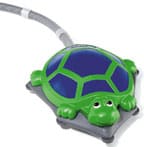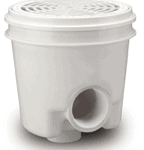A host of culprits conspire to make your pool dirty. Some are obvious—leaves, dirt, and bugs, for instance. Others are subtle and tend to sneak up over time.
Even if the surfaces of the pool—the sides, floor, steps, and tiles—look clean, they should be brushed at least every other week to clean away debris that quietly and almost invisibly accumulates such algae and mineral buildup. Be particularly careful to clean the “scum” line, where scale buildup can become an unsightly problem. If brushing doesn’t remove a line that’s starting to form, try using tile cleaner.
Recent innovations in pool-cleaning devices make sweeping, vacuuming, and scrubbing the pool less of a chore. But the old standby, the long-handled skimmer net, is a good tool for removing the big, easy-to-reach debris so that your filtration system doesn’t have to deal with it.
Suction Tools
These attach to your pool’s filtration system—usually to the skimmer—and borrow power from the pump to suck dirt and debris off the bottom of the pool, directing it toward the filter. Some models look like a long wand that you manually use to vacuum the floor and sides of the pool.
Pressure Tools
These use the return pressure supplied by the pool’s main pump or by a secondary booster pump to dislodge dirt from the sides and bottom of the pool. Usually the filter will eventually capture the debris, but some devices have their own debris collection bags.
Robotic Pool Cleaners
These units operate independent of the pool’s pump system. They are controlled by an internal computer and run on battery power. They have their own pump to supply suction power, their own filter, and their own debris collection bag.
They are the ultimate in convenience. Simply drop them in the water and let them do the work. Prices vary quite a bit. Some of the inexpensive models are getting good reviews, though the high-end products are more powerful and durable.
Built-in Pool Cleaners
You’ve probably noticed high-pressure jets in public pools. Part of an in-floor cleaning system, these built-in jets are options that homeowners can choose, too, when building a pool.
They typically add several thousand dollars to the cost of the pool, but if you can afford it, they are worth the expense because they are very effective and make it much easier to keep a pool clean. Located where dirt and scum accumulate, the jets rotate and loosen debris before it has a chance to build up and direct it toward the pool drain, forcing it to travel through the filtration system.
Swimming Pool Covers
You may think that a pool cover is an expensive luxury, but there are three practical reasons to buy one: 1) it will save you money in the long run by cutting down on energy costs; 2) it will reduce on maintenance by keeping out leaves and debris; and 3) it is a distinct safety measure.
There are a few cautions, however: Never partially cover a pool. A swimmer who goes under the cover and attempts to rise to the surface could become disoriented and be in danger. Always have the motor completely retract the cover, or pull the cover completely off the pool and store it to the side.
Energy Savings
A pool loses a great deal of heat through evaporation, but a pool cover eliminates virtually all of this loss. Depending on your climate, this can save you as much as 60 percent on your heating costs.
Keeping a cover on the pool during the night helps keep the pool warm, whether it has been heated by the sun or by a heater. A “solar” cover has air bubbles that increase the insulation value. However, if you have a standard cover on during a sunny day, you won’t get all the benefit of that solar heat. A solid-colored cover can deflect as much as 40 percent of the sun’s heat; a clear cover only deflects about 10 percent. A solar cover, though, can actually increase the heat gained from the sun.
Easy Maintenance
A cover will keep out leaves and other debris; you can simply sweep or blow them away rather than having to skim or scoop them out of the pool. This also cuts down on the work that your filter and cleaning system have to do, saving you money on those costs.
Increased Safety
Be sure to buy a cover that’s rated for safety; it should be guaranteed to support the weight of at least a child, and perhaps an adult, who falls on it. Safety covers are designed to be used in conjunction with a motor-driven retractor, which rolls the cover up or out with no effort on your part; manual covers require a significant amount of work and cannot be attached to provide enough protection. Think of a cover as an added measure of safety, but do not rely on it. It is still important to keep the area fenced with a locked gate so children and pets cannot wander in.












 Don Vandervort writes or edits every article at HomeTips. Don has:
Don Vandervort writes or edits every article at HomeTips. Don has:




